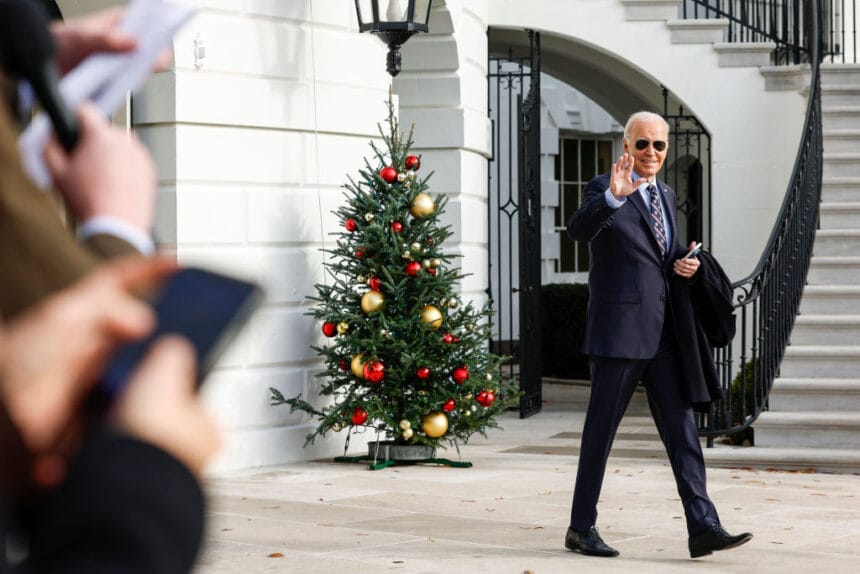The White House says big changes to drug patent policy are in store for pharma companies.
The Biden administration announced Thursday it will establish a policy that allows the federal government to dictate certain drug patents if those drug prices are deemed too expensive.
Also known as “march-in rights,” it’s the first time the federal government would exercise this type of policy to reign in drug costs.
More specifically, these march-in rights would allow the government to seize the patents of costly drugs if they were developed with federal funding, such as in partnership with the National Institutes of Health.
Technically speaking, the government has had this power for decades, but it has never used it on drug manufacturers.
Under the Bayh-Dole Act of 1980, the government has the right to “march in” and dictate the patents of products that are developed in public-private partnerships, using federal funds.
If the federal government deems such drugs to be too costly, it could then decide whether to invoke march-in rights.
The federal agency funding the research for that drug could then license the invention to a competitor that is able and willing to make it available on reasonable terms, Neera Tanden, director of the White House Domestic Policy Council, told The Washington Post.
“Fundamentally, we are establishing that price can now be a factor in determining … when the federal government can march in to ensure that we have lower prices,” Tanden added.
In an announcement Thursday, the National Institute of Standards and Technology (NIST) rolled out its draft guidance framework for march-in rights, its goal being to assist federal agencies in deciding how and when they should exercise the rights.
“March-in authority is one powerful tool to ensure that the American taxpayer is getting a fair return on their investment in research and development,” said Xavier Becerra, Secretary of the Department of Health and Human Services (HHS), in a statement. “Today’s call for comments is an opportunity to better understand how march-in authorities can impact price and better promote equitable access to prescription drugs.”
White House draws line in sand
While the set framework isn’t yet fully defined – and the White House has not yet highlighted any drugs or manufacturers in particular they might invoke the rights on – the announcement in itself is a significant one.
After the passage of the Inflation Reduction Act (IRA) last year , it appeared unlikely that the federal government would seek to enact further major drug pricing regulation in the next year or so. This was especially true amid a deeply divided Capitol Hill and an upcoming presidential election .
Still, the Biden administration has continually made a point to claim more drug regulation as a goal – and used it as a campaign talking point.
In a short video from the White House, Biden announced, “Today, we’re taking a very important step toward ending price-gouging so you don’t have to pay more for medicines than you need.”
Putting theory into practice
March-in rights, however, have long been considered a controversial option for drug pricing regulation.
In October 2022, Becerra hinted that the federal government would keep all options in mind when seeking to reduce drug prices – and wouldn’t leave march-in rights off the table.
However, most experts believed it would be unlikely that march-in rights would be used anytime soon, given the hefty industry pushback expected.
“[March-in rights] have mostly not been used because the philosophy has been, you want to promote the industry to do research and development,” said Richard Frank, a senior fellow in economic studies at the Brookings Institution, in a previous interview with MM+M . “If there’s an extent that march-in rights start to interfere with that, [people have wondered], is that the best way to try to control drug prices?”
“The [drug pricing] efforts that have been made so far have tried to take another path – negotiation, indexing on inflation, promoting more generic and biosimilar competition,” Frank continued. “The issue here is, under what circumstances are march-in rights practical and to what extent would march-in rights be completely bogged down in the courts?”
Battles over guidance await
Industry groups voiced their opposition to the Biden administration’s plan. Neil Bradley, the U.S. Chamber of Commerce’s EVP, said in a statement that the organization would use every tool at its disposal to “stop the administration from destroying America’s ability to discover the next breakthrough treatment or cure.”
“Let’s be clear, seizing patents is a confiscation of property,” Bradley said. “If patents for medicine are seized today, what property will the government seize tomorrow?”
The draft guidance comes out after the HHS spent months examining the Bayh-Dole Act, reviewing how the government could use its march-in authority specifically to lower healthcare costs.
In its announcement Thursday, NIST said it will provide a 60-day commenting period in which the pharma industry and general public can offer their thoughts on the draft guidance, after which NIST will finalize the policy.
In the interim, the Biden administration is preparing to move forward with drug pricing changes on behalf of patients.
In a call with reporters, White House advisor Lael Brainard said, “We’ll make it clear that when drug companies won’t sell taxpayer funded drugs at reasonable prices, we will be prepared to allow other companies to provide those drugs for less.”
For an April 2024 article on President Biden and Bernie Sanders touting drug pricing reform, click here.







